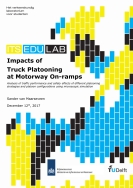This report addresses automated driving (AD) of trucks in platoons: truck platooning. Truck platooning is defined as two or more trucks driving at reduced inter-vehicle gaps (typically less than one second, corresponding with a distance of less than 22 m at 80 km/h) enabled by wireless vehicle-to-vehicle communication and of which both longitudinal and lateral control are automated. As automated vehicles on public roads become more common, road authorities have to consider action to facilitate and regulate their introduction. Before truck platooning can be introduced, platooning technology will have to prove itself safe and reliable. A main challenge lies in the largely unknown effects of the introduction of automated vehicles on mixed (conventional and automated) traffic and the nonconformity in the effects that have been researched Because the complexity of traffic dynamics on motorways is relatively low, motorways will most likely be the first type of road where automated driving will be introduced. Moreover, given the financial advantages for carriers, truck platooning on motorways might well become one of the first large-scale applications of automated driving.
The motorway merging behaviour of human drivers in the presence of truck platoons is still largely unknown. Similarly, the desired behaviour of a truck platoon in such a situation is also still largely unknown. When truck platooning on the motorway is introduced, safety issues such as crashes or merging problems can occur when human drivers want to merge on the motorway at an on-ramp if the right lane is (partially) blocked by a truck platoon. Moreover, traffic performance issues such as a breakdown of traffic can occur due to unexpected braking manoeuvres, resulting in additional traffic jams. A (temporary) decrease in traffic performance may occur if truck platoons are unable to perform at the same overall level as human drivers, which might not be accepted by road authorities if this drop in performance lasts too long.
This report describes research to identify and quantify the traffic performance and safety effects of truck platooning on the motorway at on-ramps. This is done by modelling driving behaviour of both truck platoons and conventional vehicles in mixed traffic on the motorway using microscopic simulation, for the specific case of truck platoons passing a motorway on-ramp. Thereby insights are acquired into the impacts of truck platooning at motorway on-ramps in mixed traffic on traffic performance and safety.
It has been shown that the introduction of truck platoons on the motorway will lead to merging problems at on-ramps. Therefore, truck platooning at motorway on-ramps should only be permitted under certain conditions. A time frame could be implemented, for example allowing truck platooning at on-ramps only during night time. At higher traffic intensities, especially at high on-ramp intensities, truck platooning at on-ramps is not recommended. A policy on whether truck platooning at motorway on-ramps is allowed could be based on the requirement that the number of vehicles unable to merge should not increase compared to the current situation without automated truck platoons. A role for the infrastructure might emerge in providing information to automated vehicles behind the line of sight of the on-board sensors. In that way automated vehicles can be made aware of for instance potential merging issues when approaching an on-ramp, so that truck platoons can already increase their inter-vehicle gaps or so that the arrival times at the on-ramp can be adjusted.
